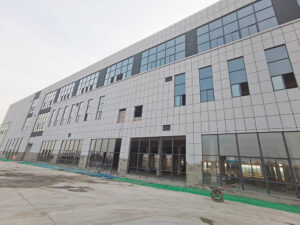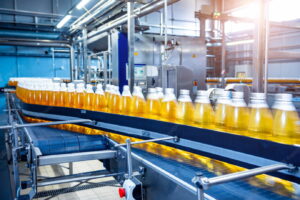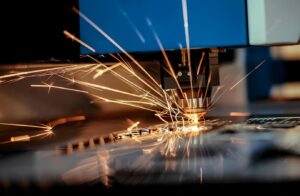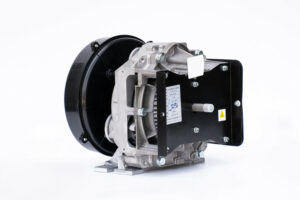
New Factory —— Decent Air Compressor
Congratulations!!!Our new factory, with workshop area of 110,000 square meters, is expected to be put into operation in January 2024!
Perfect Solution of Air Compressor for Laser Cutting Industry
The laser cutting industry must use protective gas when processing. Of course, the air is a simple and economical protective gas. The function of the air compressor for laser cutting machine is to compress a part of the compressed air with high-purity oxygen and high-purity nitrogen to provide the cutting gas for the cutting head.
Neither fiber nor CO2 lasers rely strictly on a light beam for cutting metal. Rather, the process includes the injection of an assist gas at the nozzle to supplement the process. This confluence initiates a process known as an exothermic reaction—a chemical reaction that releases energy by light or heat. The introduction of nitrogen, oxygen, or air helps transfer heat more effectively than the beam alone.
Initially oxygen was the most popular gas for the laser cutting process. Later it was discovered that nitrogen produced a cooler cut, resulting in cleaner edges, perfect for industries where aesthetics and edge quality were critical. While nitrogen remains the most widely used laser cutting gas, air is proving to be an effective and cost-saving alternative for a growing number of fabricators.
This is not to suggest that air-assisted cutting is a radical departure from nitrogen or oxygen. Air is, after all, approximately 80 percent nitrogen, with the rest consisting primarily of oxygen. The goal with air-assist cutting is to use this high concentration of nitrogen while at the same time leveraging the added benefits of substituting a slightly more diluted gas.
While relatively new to some, air-assist cutting has been around for nearly 20 years. Machine tool manufacturers began researching and developing the process as early as 1998.
Since that time the use of air as an assist gas has continued its steady growth in popularity among both fiber and CO2 laser users alike. Mode quality was a major limitation when compressed air was first introduced for CO2 lasers, but that has improved significantly. Today air-assist is an efficient and popular method for cutting a variety of materials, even stainless steel and aluminum.
Air carries with it a substantial return on investment for those employing fiber lasers or those cutting stainless steel.
The intense heat of fiber lasers, combined with injected air, creates cuts without producing an oxide formation on the cut surface. This means that secondary cleanup operations are significantly reduced or even eliminated.
As any fabricator using nitrogen will tell you, it is a costly gas. In some instances, the cost of the gas alone can be as high as 90 percent of the total operating cost. Air is considerably less expensive than both nitrogen and oxygen.
Another advantage of air is the faster cutting and increased throughput it delivers. Cutting tests on the full range of materials and thicknesses prove this out.
For example, for material thicker than 10 gauge, tests have shown that nitrogen produces faster cuts, but in the mild steel range of 10 gauge (0.135 inch) and thinner, air is roughly 3 percent faster than nitrogen. In the stainless steel range from 0.750 in. down to 20 gauge (0.036 in.), air is about 22 percent faster. In the aluminum range from 0.190 in. down to 0.032 in., air is approximately 14 percent faster.
Today businesses are scrutinizing all areas of the operation to cut costs and boost productivity. For fabricators, this puts the shop floor under a microscope.
Something as common as air can deliver measurable cost and productivity improvements. While air is generally used to cut thin material, most stainless parts, especially those used in assemblies, are candidates for air-assist laser cutting.
While clearly not the best gas in all instances, generally speaking, air produces a laser-cut edge quality that is at least comparable to parts cut with oxygen or nitrogen. In fact, if one were to label nitrogen edge cut quality as a 10, then the edge quality resulting from an air-assist cut would be about an 8. Air-assist edge quality is more than satisfactory for most powder coatings to adhere to, eliminating the need for secondary cleaning operations.
Still there are times when nitrogen remains the best gas choice. Nitrogen produces a cleaner cut, and those serving customers throughout the food processing and aerospace industries should continue their use of the gas.
Additionally, some cosmetic parts cannot show any blemish whatsoever. Again, these types of parts would not be candidates for air-assist cutting.
Is It for You?
So is air the best choice for your laser cutting operation? The short answer is, of course, maybe. It all depends on the industries you serve and how important edge quality is to you and your customers.
The bottom line is that when edge quality is absolutely critical, nitrogen remains the best option. It produces cooler cuts and is an inert gas, meaning that there is no chemical reaction when cutting stainless steel. This prevents oxidization from occurring, leaving a clean, shiny edge that eliminates secondary descaling operations.
What about setup cost? Switching your laser cutting operation to air is relatively easy and cost-effective. Even most older-model lasers can be adapted to cut with air. Although an initial investment for the proper equipment is necessary, a fabricator that taps air as an assist gas should be able to generate sustainable cost savings while boosting productivity.
While air is certainly not the optimal assist gas in all cases, it is an efficient and cost-effective alternative for many. Take a look at the parts you cut, and investigate how much you are spending on assist gas. Run some tests and determine for yourself if the answer to increased productivity and profitability isn’t literally all around you.

Congratulations!!!Our new factory, with workshop area of 110,000 square meters, is expected to be put into operation in January 2024!

How Pneumatic Systems Work Pneumatic systems operate in much of the same way as hydraulic systems do. In general, they require an air compressor, which

Contamination from compressed air is a major source of concern for the food and beverage industry. Modern manufacturing and production facilities use compressed air in

Facebook Twitter LinkedIn Perfect Solution of Air Compressor for Laser Cutting Industry The laser cutting industry must use protective gas when processing. Of course, the

A scroll compressor actually consists of two scrolls or spirals. One scroll is moving, where as the second one is fixed (attached to the compressor
Copyright © 2023 decent air compressor. All rights reserved.
WhatsApp us